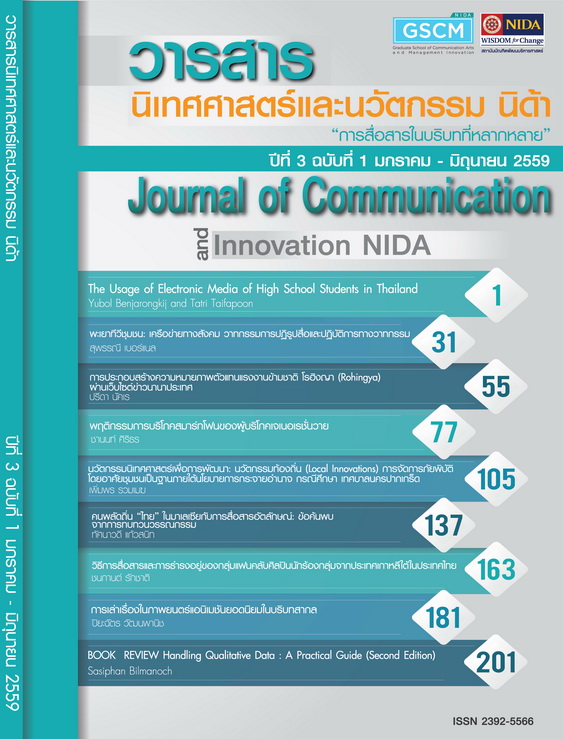นวัตกรรมนิเทศศาสตร์เพื่อการพัฒนา: นวัตกรรมท้องถิ่น (Local Innovations) การจัดการภัยพิบัติโดยอาศัยชุมชนเป็นฐานภายใต้นโยบายการกระจายอำนาจกรณีศึกษา เทศบาลนครปากเกร็ด
Main Article Content
Abstract
การศึกษาครั้งนี้มีวัตถุประสงค์เพื่อศึกษาประสิทธิภาพในการจัดการภัยพิบัติโดยอาศัยชุมชนเป็นฐาน กรณีศึกษา: เทศบาลนครปากเกร็ด โดยทำการศึกษาในมิติของการกระจายอำนาจไปยังองค์กรปกครองส่วนท้องถิ่นและลักษณะการมีส่วนร่วมของชุมชน ทั้งยังเป็นการตรวจสอบและทำความเข้าใจสภาพปัญหาและอุปสรรคด้านการกระจายอำนาจและด้านการจัดการภัยพิบัติโดยอาศัยชุมชนเป็นฐานของท้องถิ่น พร้อมทั้งเสนอแนะแนวทางการแก้ไข โดยผู้ศึกษาอาศัยการศึกษาข้อมูลจากเอกสารและการศึกษาข้อมูลภาคสนามด้วยระเบียบวิธีวิจัยเชิงคุณภาพ ได้แก่ การสังเกต การสัมภาษณ์เชิงลึก และการสนทนากลุ่ม โดยเลือกผู้ให้ข้อมูลสำคัญแบบเจาะจงจากผู้มีส่วนได้ส่วนเสียทุกฝ่าย จำนวน 12 ท่าน ประกอบด้วย ชาวบ้าน ตัวแทนขององค์กรปกครองส่วนท้องถิ่นซึ่งปฏิบัติงานด้านการจัดการภัยพิบัติ และผู้เชี่ยวชาญด้านภัยพิบัติ ส่วนในการสนทนากลุ่มมีผู้ร่วมสนทนา จำนวน 8 ท่าน เพื่อแลกเปลี่ยนความคิดเห็นในประเด็นหลัก คือ การมีส่วนร่วมระหว่างชุมชนกับองค์กรปกครองส่วนท้องถิ่น และการจัดการภัยพิบัติโดยอาศัยชุมชนเป็นฐาน นอกจากนี้ ยังศึกษาเปรียบเทียบผ่านปรากฏการณ์การเกิดอุทกภัยในปี พ.ศ. 2538 และ ปีพ.ศ. 2554 โดยมีสมมติฐานชั่วคราวในการศึกษา กล่าวคือ การกระจายอำนาจไปยังองค์กรปกครองส่วนท้องถิ่นตามแนวคิดของการกระจายอำนาจ ทำให้ท้องถิ่นมีอิสระในการจัดการตนเองและการที่ชุมชนเข้ามามีส่วนร่วมในการจัดการภัยพิบัติจะช่วยยกระดับความสามารถของท้องถิ่นในการจัดการภัยพิบัติโดยอาศัยชุมชนเป็นฐาน (Community – Based Disaster Risk Management: CBDRM) ได้อย่างมีประสิทธิภาพมากขึ้น ผลการศึกษาพบว่า ในการจัดการภัยพิบัติขององค์กรปกครองส่วนท้องถิ่น องค์กรปกครองส่วนท้องถิ่นจะต้องได้รับการประกาศพื้นที่ประสบอุทกภัยจากหน่วยงานส่วนกลางของรัฐก่อนจึงจะสามารถนำงบประมาณออกมาใช้ได้ แต่เนื่องจากเทศบาลนครปากเกร็ดเผชิญปัญหาอุทกภัยมาเป็นระยะเวลานานตั้งแต่อดีตถึงปัจจุบัน ประสบการณ์และการเรียนรู้ของเจ้าหน้าที่ของเทศบาล ประธานชุมชน และชาวบ้าน จึงทำให้มีการบริหารจัดการและการวางแผนล่วงหน้าอย่างเป็นระบบ มีความเข้าใจต่อสภาพปัญหาเป็นอย่างดีสะท้อนผ่านนครปากเกร็ดโมเดล (Pakkret Model) ซึ่งนับเป็นนวัตกรรมท้องถิ่นด้านการจัดการภัยพิบัติ กล่าวคือ นครปากเกร็ดโมเดลสะท้อนให้เห็นการวางแผนอย่างเป็นระบบ มีการอาศัยเทคโนโลยี และการสื่อสาร ก่อให้เกิดกระบวนการเรียนรู้ การแลกเปลี่ยนทางความคิดอย่างสร้างสรรค์นำไปสู่การเสนอแนวทางและการร่วมมือกันของชุมชน อาสาสมัคร องค์กรปกครองส่วนท้องถิ่นและภาคส่วนอื่นๆ ในจัดการกับภัยพิบัติโดยอาศัยชุมชนเป็นฐานเพื่อจัดการกับมหาอุทกภัยปี พ.ศ. 2554 นอกจากนี้ เทศบาลนครปากเกร็ดเป็นองค์กรปกครองส่วนท้องถิ่นขนาดใหญ่ มีรายได้เพียงพอ มีการวางแผนการใช้จ่าย มีการบริหารบุคลากรที่สอดคล้องกับภารกิจต่างๆ มีอิสระในการบริหารท้องถิ่น ประกอบกับความสามารถของผู้นำ ความเสียสละและความร่วมมือของชาวบ้านที่เป็นอาสาสมัครทั้งในและนอกพื้นที่ รวมถึงความร่วมมือระหว่างองค์กรปกครองส่วนท้องถิ่น จึงสามารถจัดการภัยพิบัติได้อย่างมีประสิทธิภาพ แม้ว่าท้องถิ่นจะมีข้อจำกัดเกี่ยวกับการขาดแคลนบุคลากรผู้เชี่ยวชาญ หรืออัตรากำลังของเจ้าหน้าที่เนื่องจากข้อกำหนดเรื่องค่าใช้จ่ายด้านการบริหารงานบุคคล กล่าวคือ กำหนดค่าใช้จ่ายไว้ไม่เกินร้อยละ 40 ของงบประมาณรายจ่ายประจำปี แต่ด้วยความร่วมมือในหลายภาคส่วนปัญหาดังกล่าวจึงไม่เป็นอุปสรรคต่อการจัดการภัยพิบัติของเทศบาลนครปากเกร็ด ข้อเสนอแนะจากการศึกษา คือ ภาครัฐควรถ่ายโอนทรัพยากรด้านการจัดการอุทกภัยให้องค์กรปกครองส่วนท้องถิ่นที่มีศักยภาพซึ่งเป็นต้นแบบในด้านการจัดการภัยพิบัติ นอกจากนี้ ควรพัฒนาข้อมูลสถานการณ์อุทกภัย ระดับน้ำ และระบบการสื่อสาร เพื่อเป็นประโยชน์กับการประสานงานกันของทุกภาคส่วน ขณะเดียวกันองค์กรปกครองส่วนท้องถิ่นควรเตรียมพร้อมเพื่อรับการถ่ายโอนภารกิจจากส่วนกลาง โดยเริ่มจากปรับปรุงโครงสร้างองค์การให้มีความเฉพาะด้าน และส่งเสริมการมีส่วนร่วมในลักษณะของเครือข่าย พร้อมทั้งสร้างจิตสำนึกด้านความปลอดภัยให้กับชุมชนท้องถิ่นและประชาชนทั่วไป
This research aims to study the efficiency of Community-Based Disaster Management: a case study of Pakkret municipality. The research focused on the decentralization of local government and community involvement aspects. The study examines and seeks to understand problems and obstacles to the decentralization and local community-based disaster management operation in order to propose approaches to problem solving. The qualitative research method through the direct observation, the in-depth interview and focus group was utilized in this study. The in – depth interview was done with 12 key informants. The focus group was attended by 8 participants who were the stakeholders from community, the Pakkret Municipality officials and disaster management experts. The comparative study between the 1995 and 2011 floods was done by having the following temporary hypothesis: the decentralization to local government according to decentralization theory allows local government to have autonomy to manage and the community involvement in disaster management will enhance the capacity of the local in community - based disaster risk management more efficient. The study found that in managing disaster, disaster zone needs to be declared first in order for the local government to be able to use any budget. Since Pakkret municipality has encountered floods on numerous occasions, the experiences and the lessons Pakkret municipality officials, community leaders, and local residents have learned allow them to systematically manage and plan ahead. Their deep comprehension of the problems reflects in Pakkret Model, which is safety and peace innovation for community. Therefore, Pakkret Model revealed its systematical planning relying on technology and communication which creates learning process, creative opinion changing led to approaches proposal and cooperation among community volunteer, local administrative offices and other sectors in community-based disaster management of 2011 flood. Besides, Pakkret municipality is the large local administrative organization that has enough income, expense planning, human resource management which is consistent with its missions. Pakkret municipality also has its autonomy as well as the capable leaders, sacrifice, and coordination from the residents both inside and outside the area along with the coordination among local government; therefore, it can manage disaster problems efficiently. Though Pakkret municipality has limited specialized officials or manpower due to the local administrative human resource management act 2009 regulation that limits the expense to be under 40% of the annual expense, the coordination among various sects made it possible for Pakkret municipality to manage disasters. Following are recommendations obtained from the study: The government should transfer mission, expert personnels, as well as resources for disaster management to local government beginning with pilot local government. Moreover, overall flood situation data and communication system should be improved. At the same time, local government should prepare to accept resources from the central government by improving organization structure to be more specialized or skilled along with promoting network coordination and safety awareness to local communities and citizen in general.
Article Details
ข้อความและความเห็นในวารสารนิเทศศาสตร์และนวัตกรรม นิด้า เป็นของผู้เขียนแต่ละท่าน มิใช่ของคณะนิเทศศาสตร์และนวัตกรรมการจัดการ สถาบันบัณฑิตพัฒนบริหารศาสตร์


